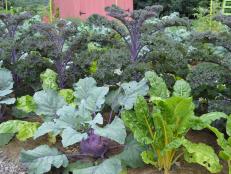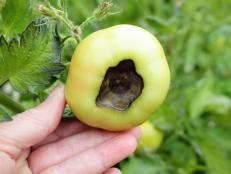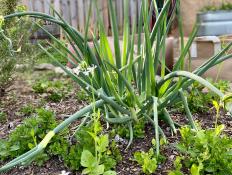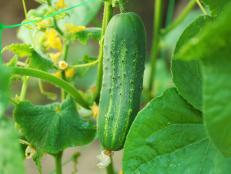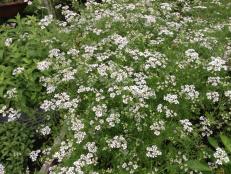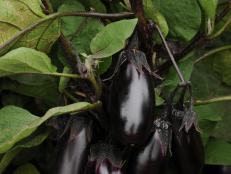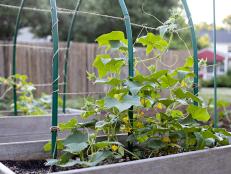How to Grow Pumpkins
These autumn favorites are one of gardening’s most fun plants to grow — and they’re really a cinch. Learn how to plant pumpkins and how to care for a bumper crop in your garden.

Craig Barhorst

What would autumn be without pumpkins? A home-grown pumpkin patch is a great way to supply fruits for pies, spooky Jack-o'-Lanterns, festive fall decor or even to compete for the biggest pumpkin prize at the county fair. Pumpkins are fun and so easy to grow. Start your pumpkins in the spring for a fall harvest.
Choosing Which Type of Pumpkin to Grow
When you flip through the pages of any vegetable seed catalog, the sheer diversity of pumpkins can make it a little tricky to choose which varieties to grow. Narrow down your choices by considering factors like plant size, days to maturity, disease resistance and how you want to use your pumpkins.
Plant Size
Growing pumpkins requires setting aside some real estate for vines to ramble. In fact, some giant pumpkins grow long vines that can take up around 1,000 square feet in the vegetable patch. Gardeners with limited space can grow a more compact, bushing variety like 'Funny Face' or small fruiting varieties that take well to trellising.
Days to Maturity: How long does it take for pumpkins to grow?
It usually takes somewhere between 80 and 120 days between planting a seed and harvesting a pumpkin, depending on the variety. Small fruiting varieties typically take less time to mature, while giant pumpkins need more time to grow, although there are exceptions depending on variety.
Disease Resistance
Pumpkins and squash are susceptible to several fungal, bacterial and viral diseases. If you've struggled with disease problems in the past, look for varieties that are listed as resistant or check with your county or state extension service to learn what varieties perform best in your area.
Types of Pumpkin
The most fun part about choosing what type of pumpkin to grow is thinking about how you're going to use your pumpkin!
10 Pumpkin Varieties 10 Photos
Learn why growing these popular pumpkin varieties is worth a try.
Jack-o'-Lantern varieties tend to have a thinner layer of flesh with a large cavity for easy carving. Although the flesh can be used for pies, Jack-o'-Lantern types are typically more stringy and bland-tasting than pie pumpkins. 'Connecticut Field,' 'Howden' and 'Igor' are a few popular varieties for carving.
Giant pumpkins have been carefully selected to grow to behemoth proportions. These varieties can weigh hundreds of pounds if they're pampered with plenty of water, sunshine, fertilizer and space to roam. 'Big Max' and 'Dill's Atlantic Giant' are a couple varieties favored by those who grow show pumpkins.
Mini-pumpkins make cute decorations that are the perfect size for little hands to carry. The small fruits are great for trellising vines without added support from slings. 'Jill-Be-Little' is a traditional orange color, 'Spark' is yellow with bright orange ribs and 'Baby Boo' has ghostly white skin.
Colorful pumpkins make stunning decorations and usually also pull double duty as delicious pie pumpkins. 'Jarrahdale' is a beautiful powder blue, 'Rouge Vif D'Etampes' has a vivid scarlet skin, 'Shiver' is pallid white and 'Speckled Hound' is orange with green splotches.
Pie pumpkins produce sweet, smooth fruit that are great for eating. There are many types of pie pumpkins that come in different sizes, shapes and colors. 'Long Island Cheese,' 'Musquee de Provence' (also called 'Fairytale'), 'New England Pie' and 'Winter Luxury' are just a few popular varieties for pies.
"Naked" seed varieties naturally produce seeds without hulls, making this type of pumpkin great for roasted pumpkin seeds. 'Naked Bear', 'Kakai' and 'Lady Godiva' are a few varieties that produce naked seeds.
Getting the Garden Site Ready
Pumpkins will thrive in a warm, sunny spot that has fertile, well-drained soil. Prepare your garden by adding lots of organic material, doing a quick soil test and following a good crop rotation plan.
Add Organic Matter
It's not uncommon to find vigorous pumpkin plants (the children of last year's Jack-o'-Lanterns) tumbling out of the compost pile and many gardeners find that these neglected pumpkins perform much better than the pampered vines growing in the garden. Part of the reason for this phenomenon is that pumpkins absolutely love growing in an environment that is rich with organic matter.
To give your pumpkins the luxuriant environment they want:
- Dig a hole where you plan to grow your pumpkins. Make the hole about 1 foot deep and 1 to 3 feet wide.
- Backfill the hole with a mixture of compost or manure with the native soil.
- Mound up the remaining mixture above the hole. Some larger fruiting varieties may need to be side-dressed with compost every three weeks later in the growing season.
Do a Soil Test
An up-to-date soil test is an important way to learn the nutrient levels, pH (or acidity) and amount of organic matter in the soil. Many soil test reports will include recommendations for how to improve the soil for specific crops, including pumpkins. It's best to use your soil test to plan your fertilizing regimen, as adding fertilizer that your plants don't need can cause pumpkins to focus more on vegetative growth than on flowering and fruiting, can cause fruit to split and can even lead to disease problems.
Practice Crop Rotation
Pumpkins are members of the cucurbit family, which includes squash, zucchini, cucumbers, watermelon and cantaloupe. These family members can be susceptible to many of the same pest and disease problems. At the end of the season, insect pests and their eggs and fungal, bacterial and viral diseases may overwinter in the soil. It will be much easier for these pests and diseases to find your pumpkins if you grow them in a spot where cucurbits have been grown in the past few years. To give your pumpkins the best possible start, group them with their cucurbit relatives in a different spot each year.
How to Plant Pumpkins
When Do Pumpkins Grow Best?
It is so tempting to plant out pumpkins as soon as the danger of frost has passed, but these heat-loving crops need reliably warmer temperatures to grow their best. Pumpkin seeds won't sprout until soil temperatures are consistently higher than 60 degrees. Seeds started later in the season when soils have warmed to 75 degrees will perform even better and may outcompete seedlings that were planted earlier. Although pumpkin vines will quickly spread through the garden, plants usually need between 80 and 120 days before fruit will be ready to harvest. If you're growing pumpkins for Halloween, a good rule of thumb is to plant pumpkin seeds by the Fourth of July.
Starting Pumpkin Seeds Indoors
If you live in a region where soils are slow to warm in the spring, or if you're just anxious to get a head start on the growing season, it is easy to start pumpkin seeds inside to plant out when the weather is more favorable. Pumpkin seedlings grow fast, so it's a good idea to start seeds in a 3-inch to quart size pot. Fill the container with potting mix, then plant a seed in the center with the pointed end facing down. If you are growing a "naked" or hull-less variety, you may want to sow two seeds per pot, then thin to one seedling if both sprout. Pumpkin plants need plenty of light, so place pots in a warm, sunny spot or below a grow light. Wait until evening temperatures are reliably in the 60's or warmer before planting in the garden.
Planting Pumpkins Outdoors
Wait until soil temperatures are consistently above 60 degrees before planting pumpkin seeds or transplanting seedlings into the garden. Check the seed packet to see how much room to allow between plants, but a good rule of thumb is to space plants about 5 feet apart. Pumpkins grow especially well in a raised mound of rich soil. Plant your pumpkin in the middle of the mound. If you are starting from seed, plant 3 seeds per mound and thin to one seedling after a few weeks.
Growing and Caring for Pumpkin Plants
Once pumpkins start growing, it's important to keep an eye on water, spread a healthy layer of mulch, protect pollinators and hand-pollinate if needed, and scout for any health issues.
Water Needs
A thirsty pumpkin will drop its flowers and lose its fruits to conserve water. Invest in a soaker hose or drip line to deliver water directly to the plant's roots. It's very difficult to water pumpkins any other way without getting water on the foliage, and wet leaves are more likely to struggle with downy or powdery mildew diseases.
Spread Mulch
Lay newspaper or cardboard on the ground around plants, then cover that level with a thick layer of straw to suppress weeds and lift fruits above the soil. Wait until soil temperatures are above 75 degrees before adding mulch, as mulch can keep soils a bit cooler than bare earth. A healthy layer of mulch will suppress competition from weeds, conserve moisture, and lift fruits above the soil. If you are planting pumpkins into a cover crop, leave the cover crop residue on top of the garden bed as a mulch rather than tilling into the soil.
If the pumpkin fruits are still pretty moist on top of the mulch, lay a shingle or some more cardboard on the ground below the pumpkin. Gently rotate the fruit occasionally so that the pumpkin will have a more even shape or color. Be careful not to damage the stem or vine when turning the fruit — it's better to have a lopsided pumpkin than no pumpkin at all!
Pumpkin Flowering
Pumpkins are monecious plants, which means that male and female flowers are produced separately on the plant. The male flowers usually arrive first, and some varieties may produce female flowers several weeks after the male flowers appear. Both male and female flowers are large and yellow, but the female flowers will have a small, immature fruit behind its petals.
Pumpkins depend on bees to pollinate their flowers. If your pumpkin plant keeps losing its immature fruits, there may be a problem with pollination. Avoid using pesticides as they will poison your bees and other pollinators.
How to Pollinate Pumpkins
To pollinate by hand, pick a male flower and rub the pollen-covered stamen on the female flower's pistil. Both the stamen and the pistil will be easy to spot – they're in the very center of each flower.
Scout for Health Issues
Pumpkins are susceptible to many pest and disease problems, including squash vine borers, pickleworms, squash bugs, cucumber beetles, powdery mildew, downy mildew, anthracnose and bacterial wilt. Pumpkin plants that are stressed out by drought, poorly drained, waterlogged soils and lack of light are more susceptible to health problems. Give plants the conditions they need to stay happy, choose resistant varieties, practice crop rotation, use good sanitation (like removing crop residues at the end of the season) and experiment with companion planting to limit health issues. If you still have trouble with pest and disease problems, reach out to your local extension service for help identifying the cause and finding a solution.
How to Harvest Pumpkins
Pumpkins should only be picked when they're fully mature – especially if you need them to store or stand on display for several weeks. Pumpkins that are ready should be fully colored with a dull, waxy skin, the outside of the fruit should be so tough that you can't puncture it with your thumbnail, the stem should be dry and corky, and the fruit may sound hollow when tapped.
Harvest the fruit when it's dry, as wet pumpkins may not store as long. Use a sharp pair of pruners or knife to cut the stem about 3 inches above the fruit. Pumpkins that have a few inches of stem attached usually store much longer than fruits without a stem.
When to Harvest Pumpkins
Learn the secrets to harvesting pumpkins so they'll stage a strong holiday display — and last long enough to fill a pie, too.
Pumpkins will tolerate a light frost — the vines may die back and the plants will stop growing, but the fruits should be just fine. Freezing temperatures, however, can damage the fruit and cause it to rot. Go ahead and harvest if cold weather is in the forecast.
Food Network Pumpkin Recipes
Get Food Network's best pumpkin recipes — from sweet treats like cake and waffles to savory dishes like pasta and soup.

.-Battle-on-the-Beach-courtesy-of-HGTV.-.jpg.rend.hgtvcom.196.196.suffix/1714761529029.jpeg)






